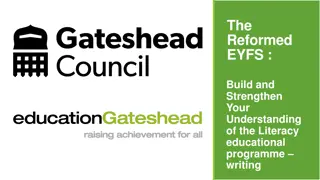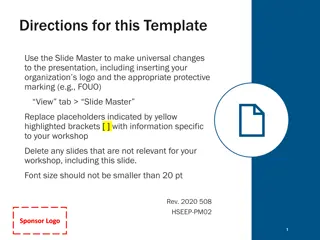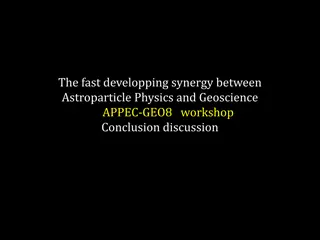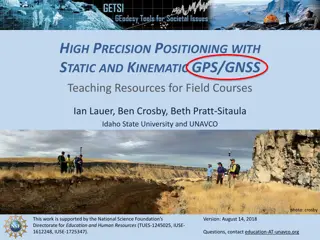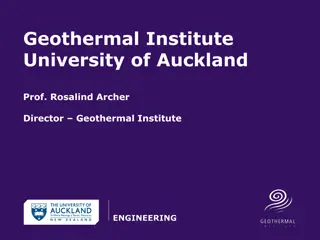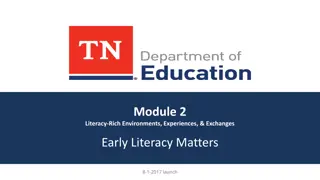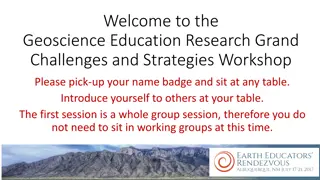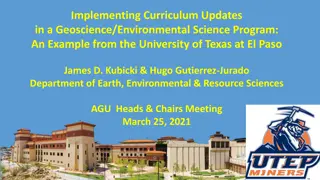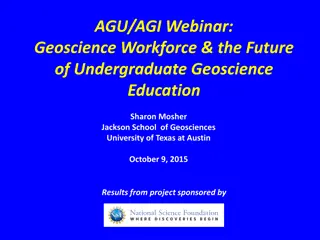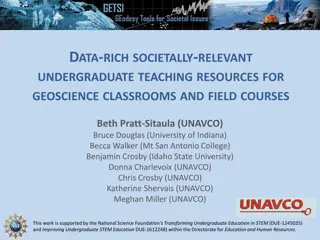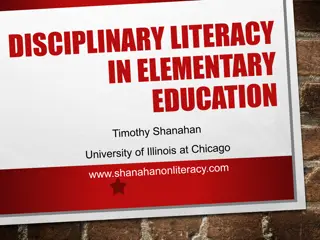Enhancing Geoscience Literacy and Workforce Preparedness through InTeGrate Curriculum Development
A comprehensive initiative supported by National Science Foundation aimed at improving geoscience literacy, integrating societal issues into undergraduate curriculum, and fostering interdisciplinary teaching. Through collaborative efforts and explicit focus on transformation of higher education, InTeGrate addresses key challenges like energy resources, mineral development, land use, biogeochemical cycles, hazard awareness, infectious diseases, climate patterns, and biological diversity.
Download Presentation

Please find below an Image/Link to download the presentation.
The content on the website is provided AS IS for your information and personal use only. It may not be sold, licensed, or shared on other websites without obtaining consent from the author.If you encounter any issues during the download, it is possible that the publisher has removed the file from their server.
You are allowed to download the files provided on this website for personal or commercial use, subject to the condition that they are used lawfully. All files are the property of their respective owners.
The content on the website is provided AS IS for your information and personal use only. It may not be sold, licensed, or shared on other websites without obtaining consent from the author.
E N D
Presentation Transcript
INTRO TO GETSI-INTEGRATE CURRICULUM DEVELOPMENT MODEL & GUIDING PRINCIPLES This work is supported by the National Science Foundation s Transforming Undergraduate Education in STEM program within the Directorate for Education and Human Resources (DUE-1245025).
A five-year community effort to improve geoscience literacy and build a workforce prepared to tackle environmental and resource issues InTeGrate supports the teaching of geoscience in the context of societal issues both within geoscience courses and across the undergraduate curriculum. An NSF STEP Center DUE-1125331
Interdisciplinary Teaching of Geoscience for a Sustainable Future Geoscience must come together with other disciplines as our nation and the world struggle with significant environmental and resource challenges. Meeting these challenges will require a savvy public, a new kind of workforce, and a broader understanding of geoscience by all who engage these issues USGS Barefoot Photographers of Tilonia
Implicit in this model is that InTeGrate supports transformation of teaching in higher education to support engaged learning.
Grand Challenges - InTeGrate Energy resource availability - balance between energy security and development of less environment-friendly sources in North America Mineral resource development - population, wealth distribution, technology, limited supplies, recycling, waste management Land use - ecosystem changes (e.g., deforestation) and implications for biological diversity and biogeochemical cycles Biogeochemical cycles - movement of key elements (e.g., C, N) Hydrologic cycles supply and demand, contamination, landscape change Hazard awareness - preparation for future natural disasters, predictions, cost/benefits Infectious diseases - environmental factors may affect distribution, transmission, severity of diseases Climate patterns - short-term time scales (seasonal, decadal), implications for severe weather events, ocean/atmosphere Biological diversity - biomes, geological past, implications for future Jones Kershaw, P., 2005, Creating a disaster resilient America: Grand challenges in science and technology. Summary of a workshop. National Research Council, http://www.nap.edu/catalog.php?record_id=11274. Global climate system - link together many of the topics on the basis of the most recent modeling for future trends National Research Council, 2001, Grand Challenges in Environmental Sciences. Washington, D.C., National Academy Press, 106 p. Zoback, M, 2001, Grand challenges in Earth and Environmental Sciences: Science, stewardship, and service for the Twenty-First Century. GSA Today, December, p.41-47.
GEODESY TOOLSFOR SOCIETAL ISSUES GETSI Develop and disseminate teaching and learning materials that feature geodesy data & quantitative skills applied to critical societal issues such as climate change, water resources, and natural hazards
GRAND CHALLENGES GEODESY/GETSI --subset of these of particular societal importance
Constructive Alignment Literacy Big Ideas Assessments Module Goals Learning Objectives
GETSI-SERC RELATIONSHIP GETSI & GETSI Field Education largely use the InTeGrate model for development (as practical) GETSI largely uses InTeGrate assessment process for module quality and student learning evidence GETSI site is hosted by SERC Ellen Iverson (SERC) will our project evaluator and lead assessment consultant (if we get the IUSE funding)
GETSI FIELD EDUC GUIDING PRINCIPLES A. Address one or more geodesy-related grand challenges facing society B. Develop student ability to address interdisciplinary problems and apply geoscience learning to social issues C. Improve student understanding of the nature and methods of geoscience and developing geoscientific habits of mind D. Make use of authentic and credible geodesy field methods and data to learn central concepts in the context of geoscience methods of inquiry E. Increase student capacity to apply quantitative skills (GETSI) to geoscience learning (InTeGrate focuses on systems thinking) * Referred to as Guiding Principles for Curriculum Design Develop systems thinking
PEDAGOGIC GOALS Engaged, student centered, research based pedagogy supports higher order learning Alignment of goals, materials and assessments supports and documents learning Develops scientific thinking and an understanding of the process of science Materials can be used successfully in multiple settings
IMPLEMENTATION GOALS Materials are used widely by faculty across the country Learning by students can be documented to show increased higher level understanding of sustainability and geoscience Materials are used in courses outside geoscience departments
LINKING GOALSAND PROCESS: THE MATERIALS DESIGN RUBRIC 1. Guiding Principles 2. Learning Goals and Outcomes 3. Assessment and Measurement 4. Resources and Materials 5. Instructional Strategies 6. Alignment
LINKING GOALSAND PROCESS: PART 2: TESTINGAND PUBLISHING Collection of assessment data Revision of materials Publication of teaching materials and supporting information for faculty Instructor Stories document implementation at different institutions
DEVELOPMENT PROCESS (+1 YEAR) 1. Materials in Development 2. Pass Assessment Rubric 3. Classroom Pilot & Data Collection 4. Review and Revision 5. Publishing
LINKING GOALSAND PROCESS: THE MATERIALS DESIGN RUBRIC 1. Guiding Principles 2. Learning Goals and Outcomes 3. Assessment and Measurement 4. Resources and Materials 5. Instructional Strategies 6. Alignment
A. GRAND CHALLENGES GPS (high precision) methods can be used to address what societal issues ? Monitoring mass movement, earthquake hazard, volcanic haz, that threatens infrastructure/life Environmental change (ex. stream change) human and natural Post disaster rescue/resource mission CHANGE DETECTION
C. NATUREANDMETHODSOFSCIENCE Integrating Geoscientific thinking into learning materials Single most important thing you can do is to simply make your thinking explicit Include opportunities for scientific communication (writing, presentations Think aloud to students as you reason through a geoscientific question Ask students to explore the uncertainty in data rather than just the data itself Add reflective prompts to existing activities that involve open- ended inquiry or research projects Ask students how and why they would address a problem rather than solve the problem (Ex. designing a field investigation) Difference between observation & interpretation
C. NATUREANDMETHODSOFSCIENCE 1. What are ways you help your students learn geoscientific ways of thinking? 2. How might it be included in the High Precision Positioning module?
D. AUTHENTICGEODESYFIELDMETHODSANDDATA Particularly critical aspect of GETSI-Field Thoughts?
E. QUANTITATIVE SKILLS What are quantitative elements of GPS? Statistics of uncertainty Interpolation Time series analysis Rate of change Datums/reference frames
THE APPROACH Identify Module Learning Goals Plan Instructional Strategies to implement teaching resources Identify learning outcomes for individual units Determine how to assess and measure student success on goals and outcomes Design teaching resources and materials to match assessments


